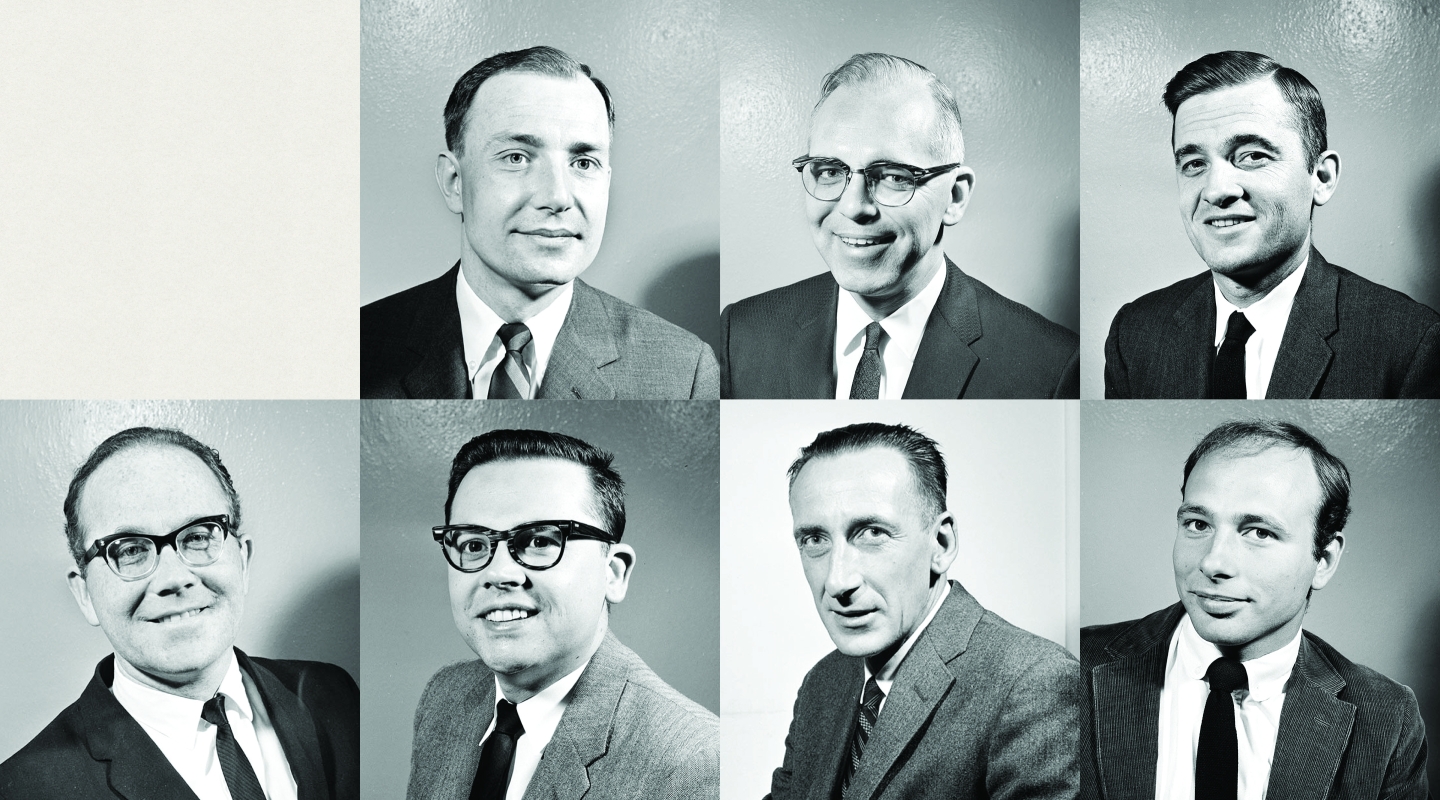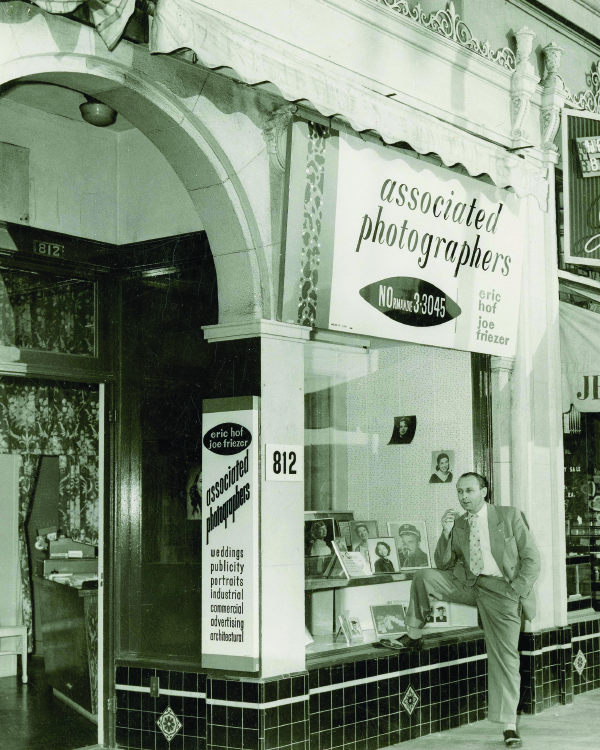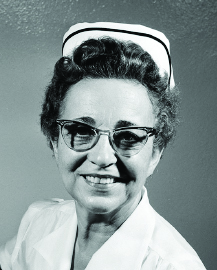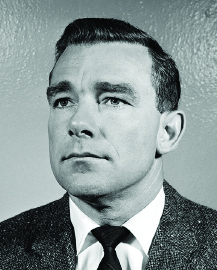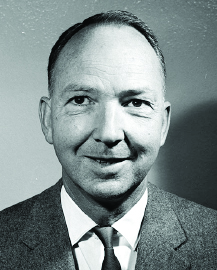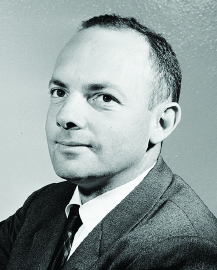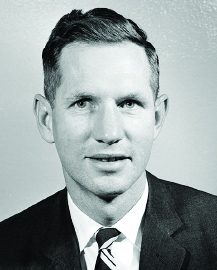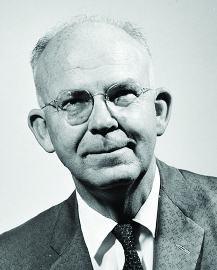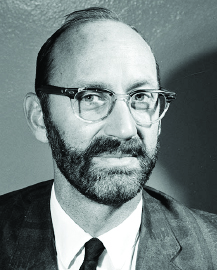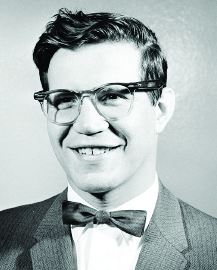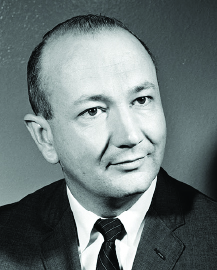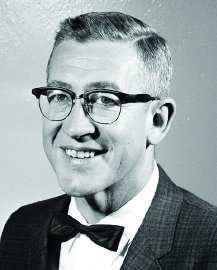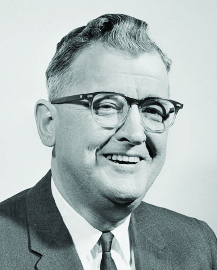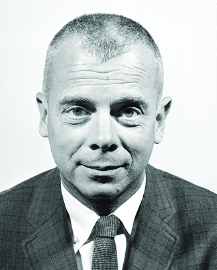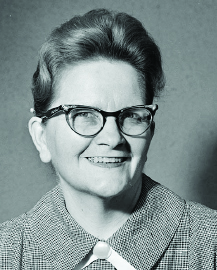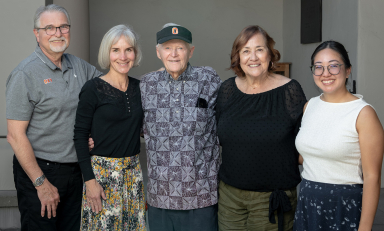A series of headshots from 1962 offers a snapshot of Oxy on its 75th anniversary—and leaves us looking for your help to identify a few unfamiliar faces
Following Joe’s death in 1998, Henk continued the family business, making the transition to digital photography around 2002. In 2015, he donated the entire photo negative archive of Friezer Photography—more than 100,000 negatives from over 15,000 photo assignments spanning more than half a century—to Occidental’s Special Collections. Eli Chartkoff, the College’s digitization specialist, recently scanned a collection of headshots taken on Oct. 29, 1962, of Oxy faculty, staff, and administrators—the kind of images you might have seen if LinkedIn had been around more than 40 years before its founding. Among the 49 subjects were dozens of familiar faces—from legendary professors and administrators to others whose time at Occidental may have been more fleeting. Collectively their stories offer a snapshot of the College at age 75.
Despite our best efforts, we have come up empty in identifying the seven individuals above—so we’re calling on you, the readers, for your help. Do any of these faces ring a bell? Send us an email with your IDs, your stories, or whatever comes to mind to oxymag@oxy.edu.
After joining Occidental in 1942 as a staff nurse, Ruby Rich Burgar ’55 began her studies toward a biology degree. She was soon promoted to head nurse, and eventually switched her major to psychology, completing her coursework after 13 years (the 1955 La Encina is dedicated to her). Burgar retired in 1974 but remained active in health care circles. She survived a tragic car accident in 1988 that took the life of the driver and one of two fellow passengers. Looking back, “As Oxy grew, so did I,” she wrote in 1995. “Sometimes I wish I could start all over again.” Burgar died in 1996.Grant Dunlap ’46’s professional baseball career is well documented, but less well known is the single season of basketball he played as a member of the Montgomery Rebels in the Southern Basketball League. Dunlap averaged 13.9 points per game with the Rebels en route to the league championship in March 1948. He hung up his sneakers to return to the diamond with the Oklahoma Indians of the Texas League. He would coach Oxy baseball for 30 years and basketball for 16 years, retiring as professor emeritus of physical education in 1984. He died in 2014.
Franklyn D. Josselyn was hired as both College chaplain and faculty member in 1955 before devoting himself full-time to teaching religion in 1962. “One of the advantages a liberal arts college has over a large university is the closer contact with a larger number of individual students,” he observed. Prior to joining the USC faculty in 1951, Josselyn served congregations in New Jersey, Pennsylvania, and California as a Presbyterian minister. A two-time recipient of the Donald Loftsgordon Memorial Teaching Award, he retired in 1980 and died on Christmas Day, 2010.
John E. Smylie arrived at Oxy in 1962, succeeding Josselyn as chaplain and joining the faculty as associate professor of religion. In a 1964 article for Southern California Presbyterian magazine, he observed, “We need churchmen in higher education not simply to teach religion, but the humanities, and social and natural sciences as well.” At the encouragement of Dr. Martin Luther King Jr., whom he met during King’s visit to Oxy, Smylie became president of Presbyterian-affiliated Queens College in Charlotte, N.C., serving from 1967 to 1974. He died in 2013.
Roy Dennis ’33 was an all-conference standout as a baseball and football player, but he secured his place in the annals of Oxy sports history by coaching the 1948 football team to victory over Colorado State in the Raisin Bowl. His swimming and water polo squads won 17 SCIAC championships and produced many All-Americans, including two-time Olympic gold medalist Sammy Lee ’43. In his eulogy for Dennis in 1988, Lee called it a miracle that “his heart had held up for 82 years because he had given a piece of it to every student he taught or coached.”
Ruth Berkey taught in the Pasadena public school system in 1960 prior to becoming a physical education instructor at Oxy. She was later dean of women, coached the women’s basketball and volleyball teams to numerous conference championships, and succeeded Roy Dennis as director of athletics in 1977. Although Berkey left Oxy in 1980 to become director of postseason events for the NCAA, she recruited much of the 1981 women’s volleyball team coached by Lesley Alward ’75 to a third-place finish in the NCAA Division III championships. She lives in Grants Pass, Ore.
Jack Stokes Ballard, assistant professor of air science, came to Occidental in 1959 after three years at Elmendorf Air Force Base in Alaska. He was also president of Oxy’s Faculty Club during the 1962-63 academic year. Ballard led the College’s AFROTC program until 1964, after which he went to the U.S. Air Force Academy in Colorado Springs. Later in his career he was an Air Force historian, and retired from the Martin Marietta Corp. in 1992. In 2017, he published The Luckiest Man Alive: The Life of World War I Aviator Captain John H. Hedley.
Donald Adams, professor of English from 1955 until his death in 1987, specialized in 19th-century British literature. He taught a popular course on detective and mystery fiction and created a bibliography of the College’s 14,000-volume Guymon Mystery and Detective Fiction Collection, donated to Oxy by 1922 graduate E.T. “Ned” Guymon Jr. Adams’ favorite? “[Sherlock] Holmes is the most lively of all detectives, virtually the most vital character in all of English literature,” he told Los Angeles Times writer Patt Morrison ’74 in 1975. “He is the perfect detective of his sort.”
Evelyn Thompson ’40 M’43—daughter of longtime English Professor Guy Thompson—worked at Anaheim Union High School before joining the Oxy faculty in 1944. She taught English literature from the outset, later adding History of Civilization to her course load. After marrying Pasadena book dealer Jay Kieffer at the family home on Campus Road in 1963, she left teaching. A second career culminated as director of alumni relations, public affairs, and development for the USC School of Education. She bequeathed Thompson House to the College with her passing in 2012.
Leland S. Babcock, professor of German from 1952 to 1985, served as a special agent of the Army’s Counter Intelligence Corps in Germany during WWII. A specialist in 18th- and 19th-century German literature, Babcock twice chaired what was then Oxy’s Languages and Linguistics Department and was the founding director of the College’s Upward Bound program in 1965, bringing 100 culturally disadvantaged students to campus for an eight-week summer session. (The program worked with 122 students in the 2018-19 school year.) Babcock died in 2010 at age 87.
Mabel Barnes, professor of mathematics from 1950 to 1971, turned heads as one of two women accepted into Princeton’s newly opened Institute for Advanced Study in 1933. “The director of the School of Mathematics took me aside and warned me that Princeton was not accustomed to women in the halls of learning and I should make myself as inconspicuous as possible,” she recalled in 1988. “In a day when it was unpopular, she tirelessly promoted careers for women in mathematics,” Professor Benedict Freedman said following Barnes’ death in 1993. After nearly 40 years of service to Oxy, Dean Ben Culley died Nov. 9, 1982, after collapsing in the middle of his math class. A notebook found in his inside coat pocket contained a handful of items, among them the 1982 Tigers football schedule, a card bearing Gary Cooper’s autograph, and a “faded, crumbling card” on which Culley had written a few lines attributed to American Quaker missionary Etienne de Grellet (1773-1855): “Any good thing I can do, or any kindness I can show any human being, let me do it now. Let me not defer or neglect it. For I shall not pass this way again.”Clifton B. Kroeber, the Norman Bridge Professor of Hispanic American History Emeritus, taught at Oxy for 35 years before retiring in 1990. (He died August 8, as this issue was going to press.) He took the surname of his stepfather, pioneering anthropologist and UC Berkeley professor Alfred Kroeber. In 2003, Clif and brother Karl revisited Alfred’s most famous subject, Ishi—the last surviving member of the Yahi nation—as editors of the anthology Ishi in Three Centuries (a companion to Ishi in Two Worlds, written by their mother, Theodora, in 1961).
Herbert Segall may have taught physics at Occidental from 1958 to 1989, but he gave an L.A. Superior Court judge a lesson in English when he was going through the jury selection process for a trial of a white supremacist in 1991. As Los Angeles Times columnist Steve Harvey relates the story, Segall was asked to disclose the occupations of his “adult children.” “I have no adult children,” he replied. “I have two adult daughters.” Pressed for clarification, “Segall, in his best professorial tone, uttered: ‘The expression adult children is an oxymoron.’ ” Segall was not selected.
Bill Hume ’50 M’52 taught music, speech, and history at Occidental before being named director of Thorne Hall in 1958. He spent almost 20 years at Occidental, also serving as director of student activities. Since his death in 1998, the G. William Hume Fellowship in the Performing Arts has brought a host of visiting artists to campus to not only perform but to lead master classes and workshops. In 1981, his mother was moved to make a 90th-birthday gift to Oxy, writing, “Personally, I have a greater fondness for Oxy than I have for Knox College, which I attended.”
George Cleland ’42, professor of organic chemistry from 1954 to 1984, grew up on the Oxy campus, where his father, 1907 graduate Robert Glass Cleland, was professor of history and administrator for more than four decades. After serving in WWII on the National Defense Research Committee, he joined a research team of scientists and engineers at the China Lake Naval Air Weapons Station outside Mojave. As a professor, he encouraged generations of Oxy students to reach for their dreams. He also was an avid fly fisherman, golfer, pianist, and cat lover. Cleland died in 2010.
As an undergraduate, Cyril Gloyn ’27, professor of philosophy from 1946 to 1971, was head cheerleader—“one of the best in Occidental history,” according to his bio—and one of the masterminds behind RUIN THE BRUIN, painted on the roof of the grandstand of Patterson Field in 1926 prior to the Tigers’ football game vs. UCLA. “Only three things went wrong,” he wrote in 1983: The oil-based paints damaged the gravel-composition roof, the money for the paints had been siphoned from the Dance Committee funds, and the Tigers lost to the Bruins 24-7. Gloyn died in 2000.Richard Reath, professor of American institutions, was a familiar presence to anyone who took History of Civilization at Oxy between 1947 and 1970. His lectures “were almost perfect examples of organization and lucidity … for a long time I thought he was a born teacher,” colleague Cyril Gloyn observed after Reath’s passing in 1989. But such command had come through years of disciplined self-criticism and appraisal. Before a History of Civ lecture, Gloyn said, Reath would practice in front of a full-length mirror, “checking pauses, changes in voice and gestures.”
Luther Jennings taught psychology and conducted research at Oxy from 1949 to 1986—and knew a photo opportunity when he saw it. Along with colleague Dave Cole M’48, Jennings visited Universal Studios in 1951 to conduct an IQ test of Bonzo, the “world’s smartest chimp” and star of Bedtime for Bonzo. (Bonzo—aka Peggy—rewarded Jennings for his efforts with a kiss on the face, which he good-naturedly wiped away.) In retirement, Jennings (who died in 2006) didn’t monkey around: He helped organize the Senior Curriculum Program at the Pasadena Senior Center.
Clancy Morrison was not quite midway through her 44-year Oxy career in 1962, when the Alabama native was overseeing the preparation of 3,000 meals a day on campus in the dining hall that generations of alumni refer to “Clancy’s” to this day. At her memorial service in 1991, emeritus professor and WWII veteran Omar Paxson ’48 recalled Morrison giving him his first job at Oxy in 1946: “I was hired on the spot at 55 cents an hour and, wow, I thought I’d seen the last of Army sergeants. … She should have been in charge at the time of the Third Army instead of Patton.”

